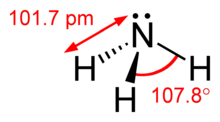User:Stewartadcock/sandbox
Below is a test chemical info box:

| ||||
| ||||
| Names | ||||
|---|---|---|---|---|
| IUPAC name
Azane
| ||||
| Other names
Hydrogen nitride
Trihydrogen nitride | ||||
| Identifiers | ||||
3D model (JSmol)
|
||||
| 3DMet | ||||
| 3587154 | ||||
| ChEBI | ||||
| ChEMBL | ||||
| ChemSpider | ||||
| EC Number |
| |||
| 79 | ||||
| KEGG | ||||
| MeSH | Ammonia | |||
PubChem CID
|
||||
| RTECS number |
| |||
| UNII | ||||
| UN number | 1005 | |||
| ||||
| ||||
| Properties | ||||
| NH3 | ||||
| Molar mass | 17.031 g/mol | |||
| Appearance | Colourless gas | |||
| Odor | strong pungent odor | |||
| Melting point | −77.73 °C (−107.91 °F; 195.42 K) | |||
| Boiling point | −33.34 °C (−28.01 °F; 239.81 K) | |||
| 47% (0 °C) 31% (25 °C) 28% (50 °C)[1] | ||||
| Solubility | soluble in chloroform, ether, ethanol, methanol | |||
| Vapor pressure | 8573 h Pa | |||
| Acidity (pKa) | 32.5 (−33 °C),[2] 10.5 (DMSO) | |||
| Basicity (pKb) | 4.75 | |||
Refractive index (nD)
|
1.3327 | |||
| Viscosity | 0.276 cP (-40 °C) | |||
| Structure | ||||
| Trigonal pyramid | ||||
| 1.42 D | ||||
| Thermochemistry | ||||
Std molar
entropy (S⦵298) |
193 J·mol−1·K−1[3] | |||
Std enthalpy of
formation (ΔfH⦵298) |
−46 kJ·mol−1[3] | |||
| Hazards | ||||
| GHS labelling: | ||||
| class="wikitable collapsible" style="min-width: 50em;" | ||||
| Pictogram | Code | Symbol description | Image link | |
 |
GHS01 | {{GHS exploding bomb}} | Image:GHS-pictogram-explos.svg | Explosive |
 |
GHS02 | {{GHS flame}} | Image:GHS-pictogram-flamme.svg | |
 |
GHS03 | {{GHS flame over circle}} | Image:GHS-pictogram-rondflam.svg | |
 |
GHS04 | {{GHS gas cylinder}} | Image:GHS-pictogram-bottle.svg | |
 |
GHS05 | {{GHS corrosion}} | Image:GHS-pictogram-acid.svg | Corrosive |
 |
GHS06 | {{GHS skull and crossbones}} | Image:GHS-pictogram-skull.svg | Accute Toxic |
 |
GHS07 | {{GHS exclamation mark}} | Image:GHS-pictogram-exclam.svg | Irritant |
 |
GHS08 | {{GHS health hazard}} | Image:GHS-pictogram-silhouette.svg | Health Hazard |
 |
GHS09 | {{GHS environment}} | Image:GHS-pictogram-pollu.svg | Environment |
See also
- {{H-phrases}}
- {{P-phrases}}
- Category:GHS templates
| Pictogram | Code | Symbol description | Image link | |
|---|---|---|---|---|
 |
GHS01 | {{GHS exploding bomb}} | Image:GHS-pictogram-explos.svg | Explosive |
 |
GHS02 | {{GHS flame}} | Image:GHS-pictogram-flamme.svg | |
 |
GHS03 | {{GHS flame over circle}} | Image:GHS-pictogram-rondflam.svg | |
 |
GHS04 | {{GHS gas cylinder}} | Image:GHS-pictogram-bottle.svg | |
 |
GHS05 | {{GHS corrosion}} | Image:GHS-pictogram-acid.svg | Corrosive |
 |
GHS06 | {{GHS skull and crossbones}} | Image:GHS-pictogram-skull.svg | Accute Toxic |
 |
GHS07 | {{GHS exclamation mark}} | Image:GHS-pictogram-exclam.svg | Irritant |
 |
GHS08 | {{GHS health hazard}} | Image:GHS-pictogram-silhouette.svg | Health Hazard |
 |
GHS09 | {{GHS environment}} | Image:GHS-pictogram-pollu.svg | Environment |
See also
- {{H-phrases}}
- {{P-phrases}}
- Category:GHS templates
| Pictogram | Code | Symbol description | Image link | |
|---|---|---|---|---|
 |
GHS01 | {{GHS exploding bomb}} | Image:GHS-pictogram-explos.svg | Explosive |
 |
GHS02 | {{GHS flame}} | Image:GHS-pictogram-flamme.svg | |
 |
GHS03 | {{GHS flame over circle}} | Image:GHS-pictogram-rondflam.svg | |
 |
GHS04 | {{GHS gas cylinder}} | Image:GHS-pictogram-bottle.svg | |
 |
GHS05 | {{GHS corrosion}} | Image:GHS-pictogram-acid.svg | Corrosive |
 |
GHS06 | {{GHS skull and crossbones}} | Image:GHS-pictogram-skull.svg | Accute Toxic |
 |
GHS07 | {{GHS exclamation mark}} | Image:GHS-pictogram-exclam.svg | Irritant |
 |
GHS08 | {{GHS health hazard}} | Image:GHS-pictogram-silhouette.svg | Health Hazard |
 |
GHS09 | {{GHS environment}} | Image:GHS-pictogram-pollu.svg | Environment |
See also
- {{H-phrases}}
- {{P-phrases}}
- Category:GHS templates
| Pictogram | Code | Symbol description | Image link | |
|---|---|---|---|---|
 |
GHS01 | {{GHS exploding bomb}} | Image:GHS-pictogram-explos.svg | Explosive |
 |
GHS02 | {{GHS flame}} | Image:GHS-pictogram-flamme.svg | |
 |
GHS03 | {{GHS flame over circle}} | Image:GHS-pictogram-rondflam.svg | |
 |
GHS04 | {{GHS gas cylinder}} | Image:GHS-pictogram-bottle.svg | |
 |
GHS05 | {{GHS corrosion}} | Image:GHS-pictogram-acid.svg | Corrosive |
 |
GHS06 | {{GHS skull and crossbones}} | Image:GHS-pictogram-skull.svg | Accute Toxic |
 |
GHS07 | {{GHS exclamation mark}} | Image:GHS-pictogram-exclam.svg | Irritant |
 |
GHS08 | {{GHS health hazard}} | Image:GHS-pictogram-silhouette.svg | Health Hazard |
 |
GHS09 | {{GHS environment}} | Image:GHS-pictogram-pollu.svg | Environment |
See also
|-
|-
| style="padding-left:1em;" |
| H221, H280, H314, H331, H400[5]
|-
|-
| style="padding-left:1em;" |
| P210, P261, P273, P280, P305+P351+P338, P310[5]
|- | NFPA 704 (fire diamond)
|
|- | Flash point | flammable gas (see text)
|-
| Explosive limits | 15–28% |-
| colspan=2 style="text-align:left; background-color:#eaeaea;" | Lethal dose or concentration (LD, LC): |-
|-
| style="padding-left:1em;" |
| 0.015 mL/kg (human, oral)
|-
|- | colspan=2 style="text-align:left; background-color:#eaeaea;" | NIOSH (US health exposure limits): |-
|-
| style="padding-left:1em;" |
| 50 ppm (25 ppm ACGIH- TLV; 35 ppm STEL)
|-
|- ! colspan=2 style="background: #f8eaba; text-align: center;" |Related compounds
|-
|
| colspan=2 style="text-align:left; background:#f8eaba; border:1px solid #a2a9b1;" |
|-
|}
- ^ Perry, Dale L.; Phillips, Sidney L. (1995). Handbook of inorganic compounds. CRC Press. p. 17. ISBN 0-8493-8671-3.
{{cite book}}: CS1 maint: multiple names: authors list (link) - ^ Perrin, D. D., Ionisation Constants of Inorganic Acids and Bases in Aqueous Solution; 2nd Ed., Pergamon Press: Oxford, 1982.
- ^ a b Zumdahl, Steven S. (2009). Chemical Principles 6th Ed. Houghton Mifflin Company. p. A22. ISBN 0-618-94690-X.
- ^ a b c d "Globally Harmonized System of Classification and Labelling of Chemicals" (pdf). 2021. Annex 3: Codification of Statements and Pictograms (pp 268–385).
- ^ a b c Sigma-Aldrich Co., Ammonia. Retrieved on 2013-07-20.




